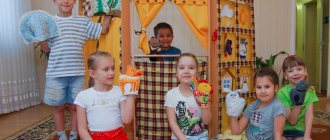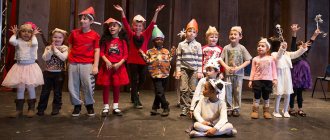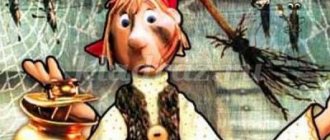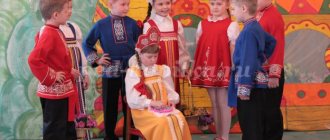MAGAZINE Preschooler.RF
Development of children's musical and creative abilities through theatrical activities.Daniya Zulkaramovna Galimova, Music Director of MBDOU – combined kindergarten No. 8.
As you know, musical and aesthetic education of children is one of the most important tasks for the harmonious development of personality. But education will be productive only if all the creative capabilities of a small person and all types of musical activities available to preschool age are used. And first of all, this is a theatrical activity. The success of musical education depends on how interesting the work on the musical and aesthetic development of children is structured.
Most educational programs provide a combination of various types of musical activities, including theatrical performances. It has a great influence on the development of a child’s creative abilities, fantasy, imagination, intelligence, artistry, communicative relationships are formed, and a friendly attitude towards each other is cultivated.
In the process of theatrical games, integrated education of children occurs: they learn expressive reading, plastic movement, singing, and playing musical instruments. A creative atmosphere is created that helps each child to reveal himself as an individual, to use his own capabilities and abilities.
In our kindergarten, great attention is paid to theatricalization. By participating in theatrical games, children get acquainted with the world around them through images, colors, and sounds. The versatile influence of theatrical games on a child’s personality allows them to be used as a strong but unobtrusive pedagogical tool, because the child feels relaxed and free during the game.
Theatrical games help create a joyful, relaxed atmosphere.
Dramatization games occupy a special place. Here the child plays himself, using his own means of expression - intonation, facial expressions, pantomime.
We begin introducing theatrical games in music classes from the first junior group. Some character always comes to visit the kids: a cat, a dog, a cockerel, etc. We make sure to greet him and come up with a name for him. Learning onomatopoeia with different intonations. We play out all the songs and chants with dolls and other toys.
In younger groups, we form in children the simplest figurative and expressive skills (the ability to imitate the characteristic movements of fairy-tale animals): birds fly, peck grains; bunnies jumping and dancing; horses are galloping and others. The whole activity is based on some kind of plot. Children themselves drive toys, dance with them, learn onomatopoeia, giving their voice the appropriate timbre. Each child tries to show himself, thereby developing facial expressions, plasticity, clear speech and correct intonation. (Photo 1).
At an older age, children actively participate in theatrical games and dramatizations. This type of activity gives children the opportunity to show creativity and imagination. Children themselves look for expressive techniques to create a game image: they come up with characteristic movements of the characters, facial expressions, different intonations, and gestures.
Since theatricalization is closely interconnected with the main types of musical activity, the need to systematize it in a single pedagogical process is obvious.
Let's consider innovative forms and methods in various types of musical activities.
1. To perceive music we use the method of active listening.
Active perception is listening to a piece of music and simultaneous transmission of the characteristic features of the musical-playing image by different types of musical creativity.
One of the main pedagogical means of activating musical perception is theatricalization, the playing out (intonation-speech and figurative-plastic) of a musical image by the teacher and children.
We pay great attention to the independent selection of movements in accordance with the nature of the music, the ability to respond emotionally to music, we develop children’s speech and their imagination.
Singing. Chanting.
To master singing skills, we use Alla Evtodieva’s wonderful songs, which are based on dialogues between different fairy tale characters. Chanting is designed for conscious voicing of the voices of heroes of familiar fairy tales, which involves singing in a medium and high voice. This role-playing singing, acting out theatrical and musical sketches with the help of voice, facial expressions and gestures effectively and qualitatively improves the effectiveness of these gaming exercises, allows children to quickly and successfully master the technique of pure intonation, artistry in singing, and contributes to the development of both vocal and theatrical abilities of the child .
Such playful chanting is multifunctional:
- Thanks to the game situation, it develops children's imaginative imagination, children's conscious understanding of the correct choice of voice (low or high) in connection with voicing familiar characters.
- Develops diction, articulation, breathing in singing.
- Develops children's creative abilities, develops theatrical skills, since play singing involves acting out theatrical sketches using various facial expressions and gestures of the characters, and singing in roles.
- Playful singing can smoothly transition into musical play - dramatization, dance, repetition and consolidation of musical-rhythmic movements, playing music.
Finger games are very helpful in work. The value of finger games in the context of the development of children's musicality lies in the fact that they represent the first experiences of performing artistry.
Working on texts with gesture drawings also helps to activate abstract and figurative-associative thinking. Finger games are original and interesting because they represent a miniature theater where the actors are fingers.
Finger games:
- develop the muscular system, fine motor skills, tactile sensitivity;
- “anticipate” consciousness, its reactivity (due to the rapidity of changes in movements);
- increase the overall level of organization of the child;
- aimed at developing a sense of rhythm, diction motor skills, expressive speech intonation, and coordination of movements.
We begin work on finger games from a very early preschool age, using texts that are short in length and simple in content and accessible to children.
In older preschool age, finger games become more complex, gestures
become the most symbolic, as a result of which the games turn into real finger-speech theater. (Appendix 1. Photo 2, 3).
Speech games allow children to master all the expressive means of music. Speech music-making is necessary, since musical hearing develops in close connection with speech hearing. In speech games, the text is sung or rhythmically recited in a choir, solo or duet. The basis is children's folklore. Musical instruments, sounding gestures, movement, sonorous or coloristic means are added to the sound. In addition, the formation of speech in humans occurs with the participation of gestures, which can accompany, decorate or even replace words. Plastic art introduces pantomimic and theatrical possibilities into speech music-making. The use of speech games in music classes and theater classes effectively influences the development of emotional expressiveness of children's speech and motor activity. (Appendix 2).
In our work we use non-traditional forms of developing musicality. These are rhythmic declamation and melodeclamation.
Melody recitation - reading poetry or text accompanied by music and singing part of the text.
Rhythmic declamation is a synthesis of music and poetry. It can be defined as a musical pedagogical model in which the text is not sung, but rhythmically recited.
The main goal of rhythmic declamation is, first of all, the development of musical and poetic hearing, sense of words, and imagination. The main rule of rhythmic declamation: every word, every syllable, sound is reproduced meaningfully, with the performer’s sincere attitude towards the sounding speech. The same text can be colored with different emotions, because... attitudes towards the same character or event can change in different ways.
Rhythmic declamation is a speech game that involves creative freedom in the intonation and rhythmic execution of the text. Depending on the goals and objectives set, almost any model can be “developed” to the level of a “theatrical production” , in which recitation, dance, singing, playing instruments, pantomime, improvisation, etc. can be combined in a variety of ratios, and can also be supplemented artistically - visual activities. Such forms are born gradually, sometimes unexpectedly, in the process of working on a model; children really like them and help them express themselves in a new situation, take a different look at already known things, enrich children’s artistic impressions, and contribute to the development of imagination and the ability to improvise.
The use of these technologies and methodological forms in practice allows us to achieve the main goal: creating an atmosphere of joyful communication, high spirits and a harmonious sense of self at music classes and holidays.
Thus, theatrical games in music classes make it possible to solve many pedagogical problems related to the formation of the expressiveness of a child’s speech, intellectual and artistic-aesthetic education.
Theatrical activity is an inexhaustible source of development of feelings, experiences, emotional discoveries, and a way to become familiar with spiritual wealth. As a result, the child learns about the world with his mind and heart, expressing his attitude towards good and evil; learns the joy associated with overcoming communication difficulties and self-doubt.
With skillful pedagogical guidance and a variety of themes, means of representation, and emotionality, theatrical games make it possible to use them for the purpose of comprehensive education and personal development. (photo 4,5, 6).
Bibliography:
- E.A. Antipova Theatrical activities in kindergarten: Games, exercises, scenarios. 2nd ed., revised. – M.: TC Sfera, 2009;
- O.A. Arsenevskaya System of musical and recreational work in kindergarten: classes, games, exercises. – Volgograd: Teacher, 2011.
- T.A. Borovik “Methods for developing children’s musicality” ; magazine “Musical Director No. 1-6 2004”
- A.A. Evtodieva Learning to sing and dance while playing: a methodological and practical guide to teaching singing and movements in a playful way. – Kaluga, 2007.
- O.V. Katser Game method of teaching children to sing: Textbook. Benefit. – 2nd ed., add. – St. Petersburg: Publishing house “Musical palette” , 2008.
Annex 1
Finger fairy tale "Mitten"
(author O. Arsenevskaya)
From behind the forest, from behind the mountains, children slap their palms as Grandfather Egor stomps. On the knees. He was in a hurry to get home - They show the other side of the mitten and dropped it. palms with the thumb extended upward - the “Mitten” .
The mouse ran across the field, “Running” with the fingers of one hand on the other hand. I saw the mitten. Gesture "Mitten" . - Who, who lives here? They knock with their right fist on their left palm. Is no one waiting for the mouse here? They wag their fingers.
She began to live and live, to sing songs loudly. Claps. A bunny ran across the field, Gesture “Bunny” . I saw the mitten. Gesture "Mitten" .
- Who, who lives here? They knock with their right fist on their left palm. Does he sing a song loudly? Claps. The mouse invited the bunny, calling him, gesturing with his right hand. She gave me some sweet tea. Stretch your arms forward, cup your palms.
The bunny jumped, the bunny hopped, baked some delicious pies. “Bake” pies. Like a fox walking across a field, soft movements with her hands. I saw a mitten. Gesture "Mitten" .
- Who, who lives here? They knock with their right fist on their left palm. Does he sing a song loudly? Claps. And the fox was invited, Soft movements of the hands. They treated us to pies. “Bake” pies.
I began to live there and sweep the floor with a broom. Hand movements left and right. The bear was walking across the field, knocking on his knees with his fists. I saw the mitten. Gesture "Mitten" .
- Who, who lives here? They knock with their right fist on their left palm. Does he sing a song loudly? Claps. The animals got scared, squeeze your fingers into a “lock” . They ran away in fear. Spread your arms to the sides.
Appendix 2:
Speech games with musical instruments
(author O. Arsenevskaya)
Matryoshka and Parsley.
Here come the funny nesting dolls Knock Knock! They brought us painted spoons. Knock Knock!
We played on spoons. Knock-knock! Knock knock! Our spoons began to dance. Knock-knock! Knock-Knock!
Here comes our friend, Petrushka, Tren-tren. He brought rattles for the guys, rattle, rattle.
The rattles rang - Ring-tink-tink! Stretch, grind, grind! They sang a loud song - Tren-di, tren-di, tren-di-tren!
Knock-knock, knock-knock, Knock-knock-knock-di-knock! It will be fun to play with our orchestra all day long!
Shur-shur-song In the silence the rustling little creatures rustle: Shur-shur, shur-shur, shur-shur. They look like little mice.
Shur-shur, shur-shur, shur-shur. Children play on “rustles” - plumes with paper or plastic strips. And somewhere a purring cat is sleeping. Mur-mur, pur-pur, pur-mur. In his sleep he sings a song:
- Mur-pur, pur-pur, pur-pur. Children play on triangles. Shur-shur! Purr purr! Shur-shur! Purr purr!
Merry orchestra. "Boom Boom! Tram-there-there!” — The drum began to beat. “Too-too-too!” —
The spoons began to play. “Beads, rosaries ,” the rattles are rattling. “Ding-dong, ding-dong!” —
The metallophone rang. “Ban-ban balalal!” - The triangle sounded! “Bumba-boomba!” —
The rumba thundered! And now we need everyone to play together.
| Next > |
Stages of working on intonation expressiveness
There are several stages in the construction of intonation expressiveness:
- Characteristics of the hero the student will play, repetition of his characteristic movements.
- Training of intonation pronunciation characteristic of a given role.
- General characteristics of speech features of the image.
- Transition into an image through creative techniques (expression of different feelings).
- Performing a poem or work in roles, taking into account the musical accompaniment of the performance.
It is especially effective when children perform a skit not just in pairs, but in a large group. Collective musical and theatrical activities help them learn to cooperate with each other and with adults.
Building intonation expressiveness is important when a specialist works with students. But it is also important to encourage them to engage in independent activities, when they themselves can choose the text, movements, intonation, etc. These are the so-called dramatization games, when they themselves choose the characters they will play, while making up speeches and singing songs.
To work on the expressiveness of speech, it is necessary to organize short five-minute sessions of articulatory gymnastics, performing various exercises. Tongue twisters, speeches and so-called phonopedic and logorhythmic exercises are also suitable, for example:
“One day, “a”, “o”, “u”, “i” went for a walk in the forest. You can count them “a”, “o”, “u”, “i”. Suddenly a bear came out of the forest “a”, “o”, “u”, “i”, And began to roar menacingly And the sounds rushed to run “a”, “o”, “u”, “i”, You and I them can't catch up. We’ll just quietly call “a”, “o”, “u”, “and”, And we’ll quickly return them home.” ,,,,,,,,,,,,,,,,,,,,,,,,,,,,,,,,,,,,,,,,,,,,,,,, ,,,,,,,,,,,,,,,,,,,,,,,,,,,,,,,,,,,,,,,,,,,,,,,, “I say hello everywhere, at home and on the street (turns right and left) I even say “hello” to the neighbor’s chicken (movement “wings”) Hello, the sky is blue (swinging your arms above your head) Hello, the sun is golden (circular movement of your fingers) Hello, free breeze (fan ourselves) Hello, little oak tree (show “little tree”) Hello, morning, (turns left and right) Hello, day, we are not too lazy to say hello.”
Musical theater thus allows you to work on all the components of oral speech of younger preschoolers.
The role of musical and theatrical activities: games and exercises
If in the last section we looked at several exercises for developing intonation, now I want to say that it is also important for children to develop their hearing and voices in order to participate in musical performances. For this purpose, you can perform the “Echo” exercise. It comes down to having the child repeat a phrase with the same characteristics that the teacher said. Those. He must repeat the timbre, volume, pitch of the sound. The phrase can be spoken or sung.
Since we are talking about singing, it is important to note that singing helps eliminate a number of speech defects, including swallowing endings and slurred pronunciation. Interesting musical and didactic tasks develop phonetic-phonemic hearing, attention and memory. For this purpose, students can be offered the following games: “Guess the sound”, “Guess the musical instrument”, “Move to the rhythm of the music” and others.
As mentioned above, the development of fine motor skills is closely related to musical and theatrical activities and the development of speech. When a child sings finger songs, his speech is enriched. Fortunately, you can now find quite a lot of such songs on the Internet.
To summarize all of the above, I would like to note that musical and theatrical activities play an important role in the development of speech of a child of primary preschool age. In addition to everything, children develop memory and attention, coordination of movements, and social behavior skills are formed. In addition, from early childhood, pupils are introduced to art and folk culture, and become acquainted with the works of great writers. By playing the role of his character, the child learns to overcome shyness and becomes more confident.




